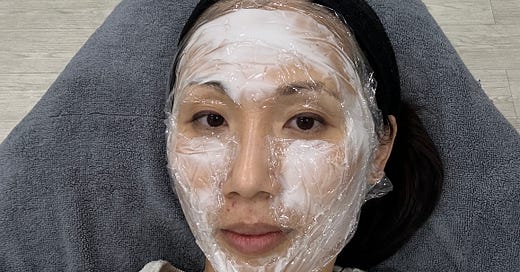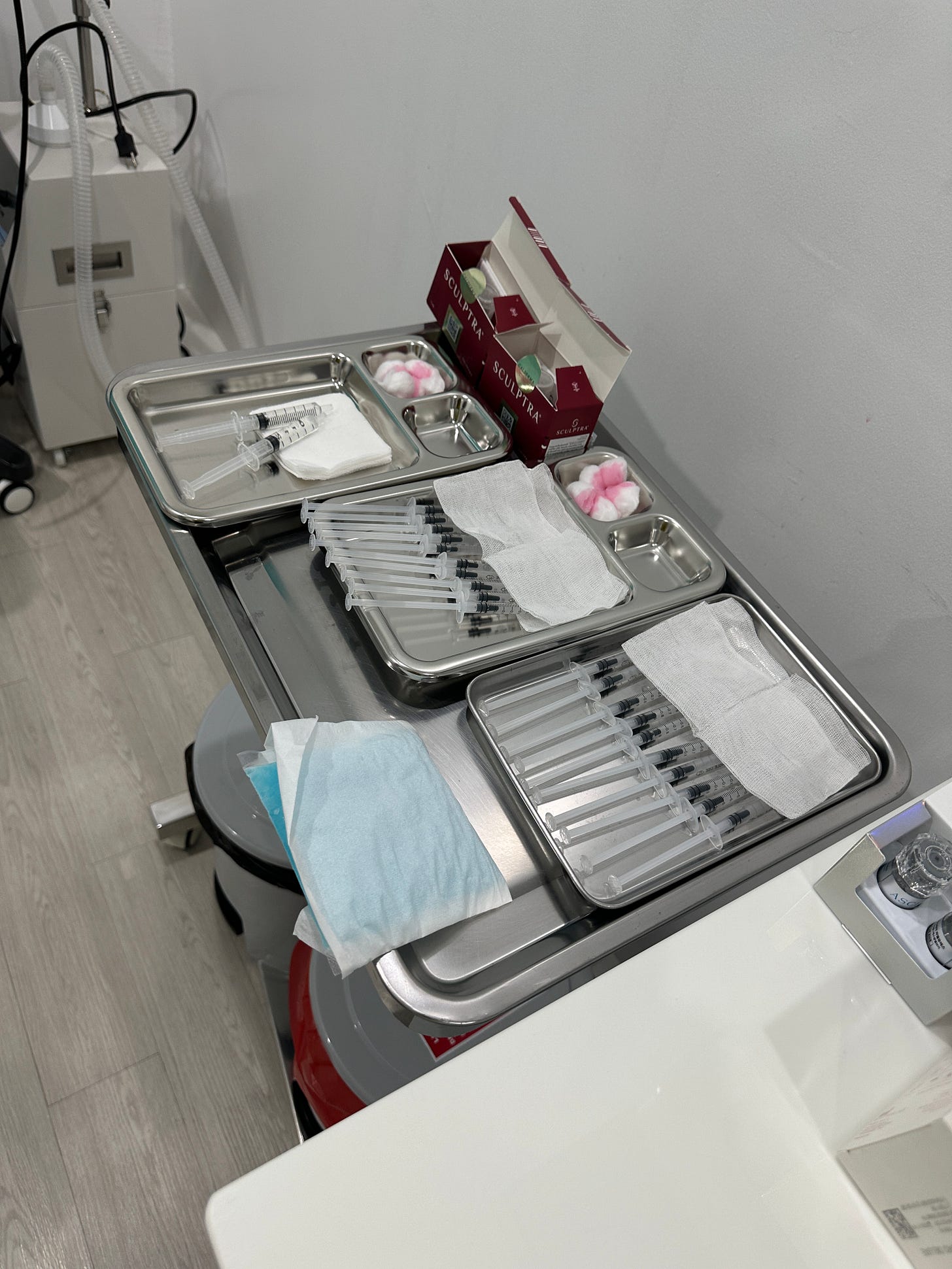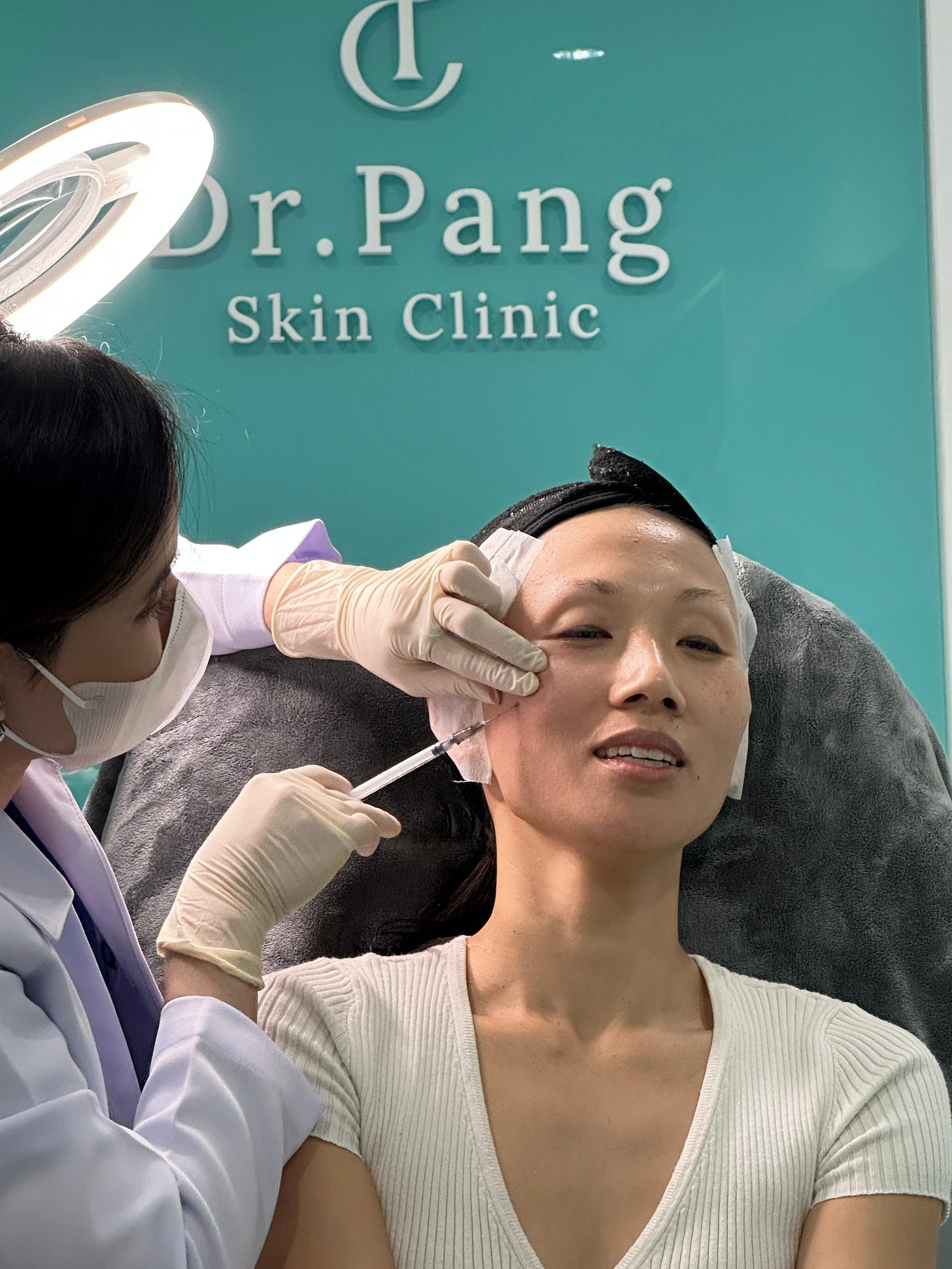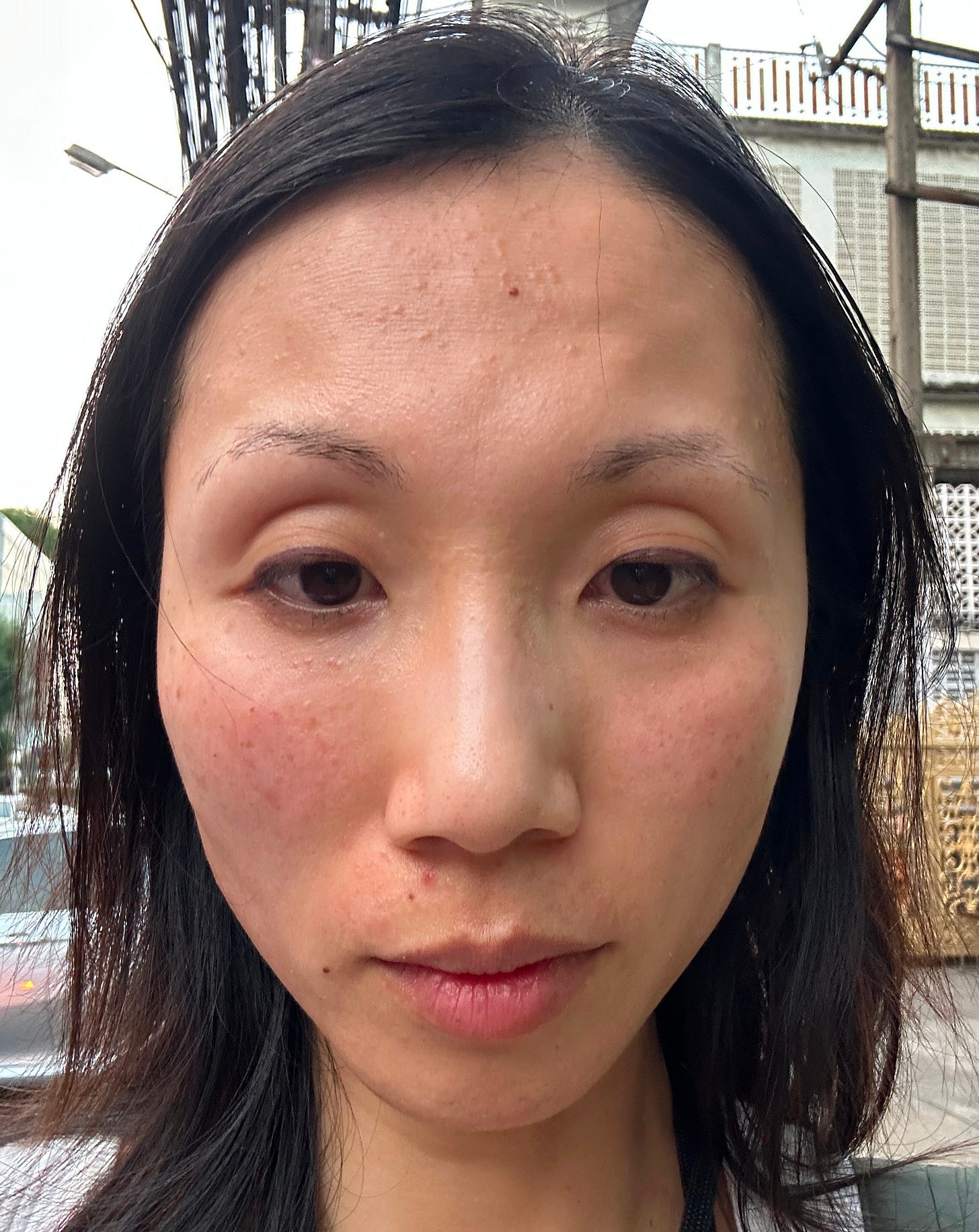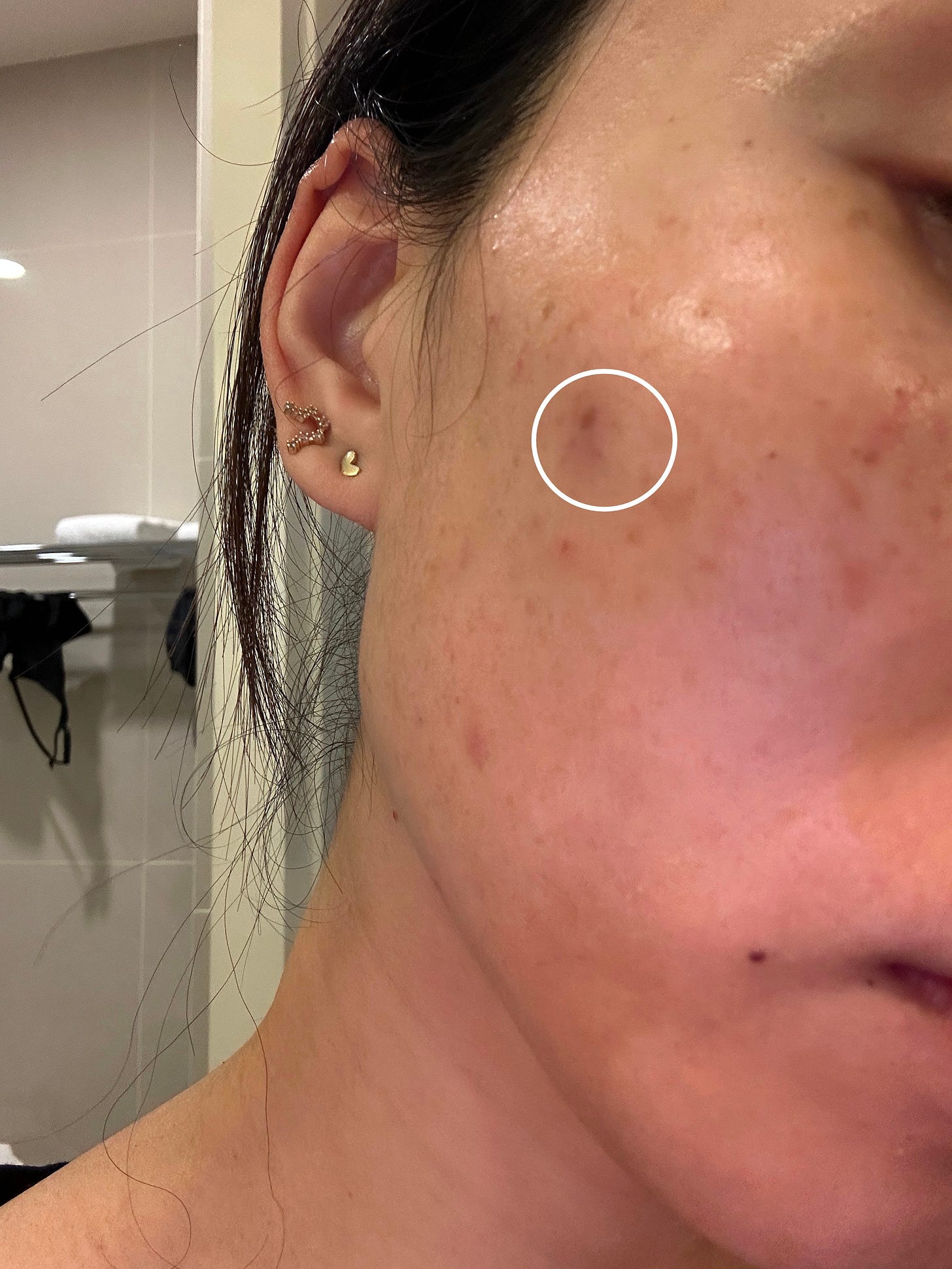Hi friends,
I’ve been wanting to share my glow-up from Bangkok for awhile now, and nearly two months later, I’m ready to spill the beans. As always please considering supporting me with a paid subscription!
Before you proceed, I suggest reading my previous post about aging gracefully (not a thing IMHO), as it lays out the rationale for why I even want a glow-up in the first place.
Why Bangkok?
We spent 3 weeks in Thailand in February, most of it based in Bangkok. The primary reason is that our close friends are from Bangkok and spend half the year there. Before our trip, I had planned for my 40th birthday glow-up to happen in Seoul this April (still happening, there’s a lot of good content I’ll share after my end-of-April Seoul trip), but when our friend K told us about his med school classmate who is a licensed dermatologist in Bangkok, I was intrigued.
When I lived in China, a lot of expats without medical insurance would fly to Thailand for its inexpensive and excellent medical care. That is still the case today, and even a lot of Chinese nationals will go to Thailand for quality care. K and his dermatologist friend, Dr Pang, both graduated from the prestigious Chulalongkorn University, and Dr Pang undertook additional training in dermatology and is board certified. This is critical because Kunakorn told me that most doctors operating dermatology and aesthetic clinics in Thailand are not board certified - they just have four years of undergraduate medical education and since it’s lucrative to do aesthetics, many jump on the bandwagon. In the US, only board-certified dermatologists can open dermatology clinics, but that is not the case in Thailand, so do your research.
Why not the US?
I explain all this because most people’s first reaction to me getting a glow-up in Thailand is, “Um…is it safe to do it there?” The short answer is yes if you do it with a board certified dermatologist who has trained at reputable places, which is what Dr Pang did. Also, Thailand is among the first importers of whatever new treatments and technologies come out of Korea, which is still the holy grail for aesthetic dermatology. Therefore, whatever is available in Korea is also commonly available in Thailand, for example the famous Rejuran Healer treatment, which is a skin booster derived from salmon sperm (yes, salmon sperm), as well as Thermage and Ultherapy for lifting and tightening. These are available at some clinics in North America but are much costlier.
What was the process like?
Since Dr Pang is a friend of a friend, I added her on WhatsApp (she prefers Line) and sent her pictures of my face, as well as my skincare concerns (loss of volume/collagen, sun and aging spots). She recommended that I consider Rejuran Healer, Sculptra, and LinearZ for the loss of collagen in my face. She said that Rejuran is bio-regenerative (revitalizing old cells), Sculptra is bio-stimulatory (triggering your body’s new production of collagen and elastin over time), and that LinearZ helps lift sagging skin and stimulate focal fat proliferation. I did research on all three, and decided that Sculptra was my first treatment of choice and that I would consider other treatments once I had an in-person consult with Dr Pang. I like the fact that that Sculptra is not a filler, but rather an injectable that stimulates my own body’s production of collagen - everyone’s results will differ, and they will look like themselves, not like a standardized everywoman.
Once I got to Bangkok, I rested for a couple of days to adjust to jet lag, and then saw Dr Pang at her clinic on my fourth day. Unlike many aesthetic derms in the US, she actually also works in the hospital on non-elective procedures like skin cancer surgeries etc. That also made me feel confident in her surgical skills, because she treats medically necessary dermatology cases, not just “I wanna look prettier” cases. She knows the skin inside out - remember, the skin is our body’s largest organ and highly complex!
Dr Pang looked at my face and skin close up, and chatted with me about what my priorities were. We agreed that Sculptra was definitely on the table, but I decided not to try Rejuran Healer because it does have a downtime (your face looks like a red cheese grater afterwards, although the Rejuran HB version apparently has a lighter touch) and I didn’t want to freak out my kids. I also subscribe to the philosophy that less is more - I don’t believe in having 7 treatments at once, because then how do you know what actually works? We then discussed pico brightening laser for my sun spots and skin dullness, and I decided to add that on before my Sculptra injections. Finally, Dr Pang suggested finishing with a skin booster (Rejuran is also considered a booster), which is very commonly tacked on at the end of more invasive treatments like Sculptra. She recommended either an exosome booster or the Neauvia booster, both of which hydrate and rejuvenate - frankly, I couldn’t really understand the difference so I picked Neauvia, because it’s a newer product and not once that I’ve seen in the US.
I recommend that before undergoing any decisions about your skin, even with an expert like Dr Pang, you need to do your own research into each of the treatments, see before and afters, and consider what it is you want. I was very specific on wanting to increase the collagen that I had lost after having 2 kids and from aging - this is what led to me looking skeletal, as my orbital bones were literally protuberant on my face 💀. For me, the worst thing to do is to see a picture of a 24 year old and say, “I wanna look like her, give me all the treatments.” No no, I want to look like me, but address the physical decay that sleepless nights and postpartum anxiety and stress has caused in my face and body. I don’t want to look like a 24, year old influencer I want to look like a healthy me.
Prepping for the procedure
Dr Pang recommended doing the Pico brightening laser first, as that can be done without numbing my face. They put a little metal eye cover on my eyes, and the laser was quick - it felt like pleasant little prickles on my face. 1/10 in discomfort.
Afterwards, her nurse applied numbing cream all over my face, and sealed it in with plastic wrap. I waited one hour for it to take effect - it’s kind of like having lidocaine on your face, so if you’ve had dental procedures done, you know what I mean.
Then, it was injection time. It’s generally recommended to have 2-3 sessions of Sculptra, each spaced out 2 to 3 months. This is what Dr Pang told me, and also what I came across in my research. However, since Sculptra results vary by each person and each person’s desired outcome and starting point are different, this is not a hard and fast rule. For example, beauty influencer Amy Chang, whom I follow, only had one session of Sculptra and she was happy with her results. However, she didn’t share how many cc's were injected and also what her concerns were before, and also her results after. The rule of thumb is that you do one cc for every decade of life, but again, desired results vary. This is an art and a science.
Dr Pang chose to inject 2 cc’s in my session, and you can see how many syringes it is when the Sculptra powder is reconstituted with sterile water 😱. Yes all of that went into my face.
How painful was it?
I’m going to be very honest here - it was pretty uncomfortable and I have a high pain tolerance threshold (I had an unmedicated birth with my first and apparently contractions that would be painful to others register as a blip to me, not sure why). It’s not so much that there was pain, but rather the sensation of the needle expelling fluid under the dermis felt strange to me. Yes, my face was numbed, but that only numbs the surface. Dr Pang said that when the needle goes underneath the superficial skin, you can still feel the needle, especially if it comes near a nerve, which it did for me once. I didn’t feel the urge to cry, but I definitely did grip the pillow tightly. The best way I can describe the sensation is using the dental procedure analogy. You know how even though your gums are numbed, when the dental tools go underneath the numbed gums, you can definitely feel it? It’s like that, but more intense, for your face. I don’t have a reference for how it should feel as this was my first time getting an injection in my face, but I would think that Dr Pang is fairly skilled.
By contrast, the booster, which was also administered with needles but more superficially (not underneath the dermis), felt like pleasant little pricks because the needle didn’t go past the numbed skin surface.
Results
Sculptra is not known for immediate results. Since it is bio-stimulatory, you have to wait 1.5-2 months for your body to start reacting to the Sculptra and generate collagen.
Right afterwards, my face was a bit puffy and you can see the areas of injection. It is critical to do the 5-5-5 massage: 5 minutes of facial massage 5 times a day for 5 days. Otherwise, the injected fluid can collect in your face if not properly distributed with massaging. Anybody complaining about lumps likely did not follow the massage protocol.
You’re supposed to avoid putting makeup in the area for 12 hours, so I left my face clean for the remainder of that day (I finished at 5pm) and started wearing light makeup the next morning.
I had some light bruising at one of the injection sites for about 5 days after the procedure, nothing that makeup couldn’t cover. No physical symptoms or reactions.
So what’s the cost?
Here’s the cost breakdown with conversion rates as of February 6, 2025 and rounded up
Pico brightening laser 7900 THB/USD$236 for one treatment
Sculptra 29,900 per bottle (each bottle is 1 cc)/USD$890 per bottle
Exosome booster 14,900 per bottle (I did not choose this booster)/USD$444 per bottle
Neauvia booster 14,900 per bottle (I chose this booster and Dr Pang administered 2 cc’s)/USD$444 per bottle
No tax, and I received a 15% friends & family discount (since Dr Pang is a friend of my good friend). If you plan to go to Bangkok, dm me and I can refer you for the same 15% discount.
Based on my research, Sculptra in the US can cost up to 2x what it cost in Bangkok. Prices fluctuate pretty wildly depending on where you’re located and who you’re seeing. Plus, there’s tax in most US states. Pico brightening laser prices also vary, depending on the mode that is being used by the dermatologist and if it’s in a package of multiple sessions (which is recommended). I think the Bangkok price is on the lower end of what you’d pay in the US, and no taxes.
Neauvia is not available in the US as a booster, based on my research, although exosome boosters are, and the prices I’ve found quoted on US clinic websites are $500-$800.
Below is a screenshot of Amy Chang’s calculations on treatments in US vs Korea. It’s a bit incomplete because she doesn’t indicate how many cc’s would be administered to the tune of the US prices she quoted, and that matters A LOT. The pricing for 2 cc’s of Sculptra is VERY different from 4 cc’s of Sculptra. She’s also based in LA so there’s regional pricing bias that’s not called out explicitly. Anyway, it’s a good reminder that treatments are always cheaper and better in Korea and Bangkok IF you find a reputable clinic.
What’s next?
I’m going to Korea at the end of April for a glow up trip with some girlfriends and I’ve arranged to go to a clinic that local Seoulites visit, rather than one patronized by influencers. I’ll do a writeup after and maybe YouTube videos. Let me know if you all prefer writing or video!
I’d also love to do a fat transfer (also known as fat grafting) for the extreme concavity under my brow bones - that’s a major sign of aging and collagen loss that even Sculptra can’t fix and Dr Pang said that the only thing that will fix it is a fat transfer/graft. I don’t want fillers and a fat transfer is better because the results are permanent. I might opt to do this with Dr Pang the next time we visit Bangkok.

